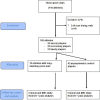Long-standing groin pain in contact sports: a prospective case-control and MRI study
- PMID: 31191965
- PMCID: PMC6539155
- DOI: 10.1136/bmjsem-2018-000507
Long-standing groin pain in contact sports: a prospective case-control and MRI study
Abstract
Objectives: We aimed to prospectively evaluate the prevalence of long-standing groin pain and related MRI findings in contact sports.
Methods: This case-control study followed three male elite-level soccer, ice-hockey and bandy teams (102 players) for 2 years. All athletes with long-standing groin pain lasting >30 days and age-matched controls (1:3) from the same teams were examined clinically, using pelvic MRI and Hip and Groin Outcome Scores (HAGOS). Primary outcome measures were annual prevalence of groin pain and underlying MRI findings.
Results: The annual prevalence of chronic groin pain was 7.5%. Training characteristics and pain scores of athletes were similar in all teams. On MRI, there was no significant difference in the percentage of pubic bone marrow oedema (p = 0.80) between symptomatic players (8/15; 53%) versus controls (20/43; 47%), but adductor tendinopathy and degenerative changes at the pubic symphysis were twice more common among players with pain. Rectus muscle or iliopsoas pathology were seldom observed. Lower HAGOS subscales (p < 0.01) were recorded in players who experienced groin pain compared with the controls.
Conclusion: Long-standing groin pain was observed annually in 1 of 14 athletes in contact sports. Abnormalities in the pubic symphysis were common MRI findings in both symptomatic and asymptomatic players.
Trial registration number: NCT02560480.
Keywords: MRI; groin; injuries.
Conflict of interest statement
Competing interests: None declared.
Figures



Similar articles
-
MRI findings in athletic groin pain: correlation of imaging with history and examination in symptomatic and asymptomatic athletes.Skeletal Radiol. 2025 Apr;54(4):841-850. doi: 10.1007/s00256-024-04603-9. Epub 2024 Feb 2. Skeletal Radiol. 2025. PMID: 38302788 Free PMC article.
-
Pubic-Related Radiographic Findings in Male Football Players With Long-Standing Groin Pain, and Asymptomatic Controls - Are They Clinically Relevant?Scand J Med Sci Sports. 2025 May;35(5):e70068. doi: 10.1111/sms.70068. Scand J Med Sci Sports. 2025. PMID: 40356593 Free PMC article.
-
MRI findings in soccer players with long-standing adductor-related groin pain and asymptomatic controls.Br J Sports Med. 2015 May;49(10):681-91. doi: 10.1136/bjsports-2014-093710. Epub 2014 Dec 15. Br J Sports Med. 2015. PMID: 25512059
-
Measuring the Hip Adductor to Abductor Strength Ratio in Ice Hockey and Soccer Players: A Critically Appraised Topic.J Sport Rehabil. 2020 Jan 1;29(1):116-121. doi: 10.1123/jsr.2018-0250. J Sport Rehabil. 2020. PMID: 30676199 Review.
-
Radiological findings in symphyseal and adductor-related groin pain in athletes: a critical review of the literature.Br J Sports Med. 2013 Jul;47(10):611-9. doi: 10.1136/bjsports-2012-091905. Epub 2013 Feb 12. Br J Sports Med. 2013. PMID: 23403531 Review.
Cited by
-
Reviewing Bone Marrow Edema in Athletes: A Difficult Diagnostic and Clinical Approach.Medicina (Kaunas). 2021 Oct 22;57(11):1143. doi: 10.3390/medicina57111143. Medicina (Kaunas). 2021. PMID: 34833361 Free PMC article. Review.
-
Long-standing pubic-related groin pain in professional academy soccer players: a prospective cohort study on possible risk factors, rehabilitation and return to play.BMC Musculoskelet Disord. 2021 Nov 17;22(1):958. doi: 10.1186/s12891-021-04837-x. BMC Musculoskelet Disord. 2021. PMID: 34789227 Free PMC article.
-
The Role of MRI in Groin Pain Syndrome in Athletes.Diagnostics (Basel). 2024 Apr 14;14(8):814. doi: 10.3390/diagnostics14080814. Diagnostics (Basel). 2024. PMID: 38667460 Free PMC article. Review.
-
MRI findings in athletic groin pain: correlation of imaging with history and examination in symptomatic and asymptomatic athletes.Skeletal Radiol. 2025 Apr;54(4):841-850. doi: 10.1007/s00256-024-04603-9. Epub 2024 Feb 2. Skeletal Radiol. 2025. PMID: 38302788 Free PMC article.
-
Developing a simple risk metric for the effect of sport-related concussion and physical pain on mental health.PLoS One. 2023 Oct 13;18(10):e0292751. doi: 10.1371/journal.pone.0292751. eCollection 2023. PLoS One. 2023. PMID: 37831707 Free PMC article.
References
Associated data
LinkOut - more resources
Full Text Sources
Medical
